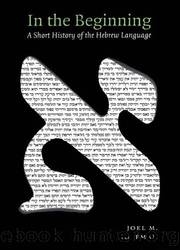In the Beginning by Joel Hoffman

Author:Joel Hoffman
Language: eng
Format: epub
Publisher: NYU Press
Published: 2004-06-15T00:00:00+00:00
What Are the Dead Sea Scrolls?
Thousands of documents have been retrieved from the caves in Qumran. MartÃnez (1996) divides the content into nine non-Biblical categories, recognizing that his categories overlap to some degree, and that not all of the documents fit precisely into any category.
The list below gives a sense of the documents found in the caves at Qumran, and of their potential significance for understanding both the Hebrew of 2,000 years ago and for putting the Hebrew that came before and after into context.
Here are MartÃnezâs categories, along with a tenth category (âBiblical materialâ).
1. Rules. These are very general documents, typical of Qumran (and later Christian periods, as well) that describe myriad aspects of life in the Qumranic society. Their content includes rules and regulations (hence their technical name), as well as a variety of tangents. The best-known Rule is the âRule of the Communityâ (copies of which were found in Caves 1, 4, and 5), describing the Qumranic way of life. Because that Rule describes Qumran itself, and was therefore almost certainly written by the people there, it offers us insight into the Hebrew that was actually in use in Qumran.
2. Halakhic Texts. âHalakhaâ is Jewish law. While many of the DSS, including the Rules and some exegetical material, contain halakhic writing, some documents were devoted primarily to halakha, and even sometimes to the differences between halakha in Qumran and elsewhere. Like the Rules, these offer us information about the Hebrew of Qumran in addition to their valuable content.
3. Eschatological Literature. âEschatology,â from the Greek (εÏÏαÏoζ) meaning âlast,â is the department of theology that deals with what happens when things end: death, the end of the world, final judgment, and so forth. To judge from the documents we have retrieved, the Qumranic Sect was obsessed with the imminent end of days, and much of their literature has eschatological themes. But some documents focus exclusively on such matters, including the War Scroll, one of the first scrolls found in Cave 1. These documents, too, were probably written at Qumran, and offer evidence both about the state of Hebrew at the time and the people who wrote them.
4. Exegetical Literature. âExegesisâ is the process of interpreting (usually religious) text. The exegetical DSS are documents that deal with interpreting the traditional Bible as we know it today, and offering commentary on it. Some of these texts are in Aramaic, putting them in a category with other translations and interpretations into Aramaic known as targums. Others are in Hebrew, offering midrash-like interpretations of the Bible. Because these do not deal directly with Qumran, it is more difficult to know whether these were composed by members of the sect, copied from memory by those members but composed earlier, or, even, imported from elsewhere.
5. Para-Biblical Literature. In terms of content, this is some of the most interesting material. The corpus of DSS contains considerable material that looks Biblical, but which does not appear in the traditional collection of âthe Bible.â
Of particular interest are the ânon-canonicalâ psalms.
Download
This site does not store any files on its server. We only index and link to content provided by other sites. Please contact the content providers to delete copyright contents if any and email us, we'll remove relevant links or contents immediately.
Housekeeping by Marilynne Robinson(4390)
Papillon (English) by Henri Charrière(4223)
The Poetry of Pablo Neruda by Pablo Neruda(4061)
World without end by Ken Follett(3445)
TCP IP by Todd Lammle(3153)
Fluent Forever: How to Learn Any Language Fast and Never Forget It by Gabriel Wyner(3051)
The Rape Of Nanking by Iris Chang(2795)
How Proust Can Change Your Life by Alain De Botton(2769)
The Alchemist by Paulo Coelho(2668)
The Partner by John Grisham(2365)
Two lives by Helen Naylor(2281)
Hitler by Ian Kershaw(2168)
Yerma by Federico García Lorca(2041)
Sophie's World by Jostein Gaarder(1993)
Smilla's Sense of Snow by Peter Hoeg(1920)
Merriam-Webster's Pocket Dictionary by Merriam-Webster(1906)
Twilight of Idols and Anti-Christ by Friedrich Nietzsche(1870)
Il cavaliere inesistente by Italo Calvino(1839)
Deep Writing by Eric Maisel(1798)
